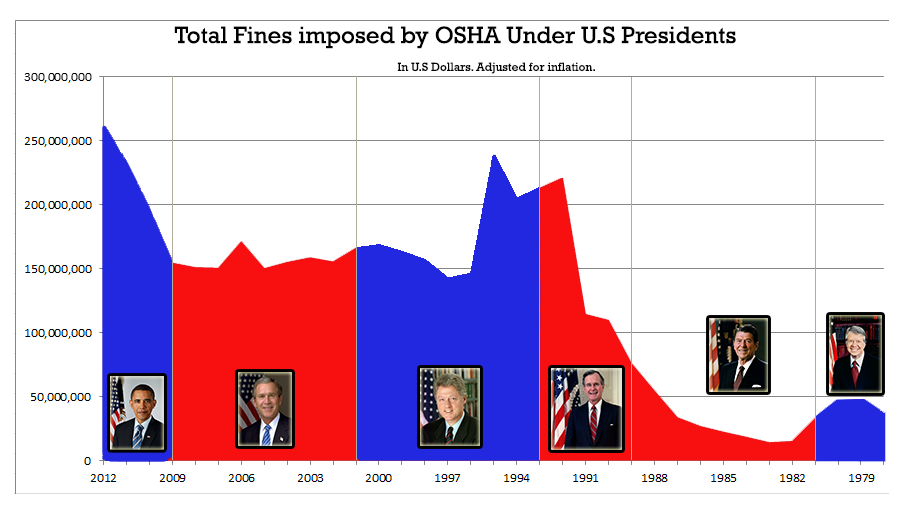November 24, 2012
A Detailed Look Into OSHA under U.S Presidents

November 24, 2012

Democrats and Republicans could not be more different in their fundamental views of government spending and regulation but are these views reflected in their administration of OSHA? In this article, we will explore the significant differences and similarities in how these political parties have shaped OSHA over the years, analyzing their impacts on worker safety and rights.
Understanding the policies under various U.S Presidents can help us appreciate the evolution of workplace safety regulations.
Increasing maximum OSHA fines requires action from Congress which has been repeatedly blocked under the current Republican congress. However, that hasn’t stopped OSHA from finding other ways to increase fines under the leadership of Obama-appointed David Michaels, such as increasing minimum mandatory fines and increasing the window whereby an employer can be classified as a ‘repeat offender.’ These changes have resulted in record years for OSHA fines, as evident in the charts below. For instance, the year 2016 saw fines reaching new heights, reflecting a significant shift in enforcement and compliance expectations from businesses.
These shifts in OSHA fines can be traced back to the influence of different U.S Presidents on labor policies.
OSHA fines, often called a ‘hidden tax’ by critics, first exploded under George Bush Sr. His presidency marked a pivotal moment in OSHA’s history, influencing future regulations under successive U.S Presidents. They remained relatively stagnant under Clinton and George W., who favored a more business-friendly approach. However, under Obama, fines surged again due to a new set of guidelines and a renewed focus on workplace safety.
New OSHA regulations have come to a screeching halt at the beginning of the George W. Bush administration. This is due to a variety of reasons, not the least of which is the ever-increasing influence of business in politics. During this time, many industry groups lobbied aggressively against new regulations, arguing that they hindered economic growth. This situation created a precarious balance between ensuring worker safety and fostering a favorable climate for business expansion.
Obama has created new regulations more than twice as quickly as George W., although it is incredibly slow when compared to the first 30 years of OSHA’s existence. Regulations were issued at the rate of 2.3/yr under the Republican Reagan administration. This rapid pace of regulation under Obama was frequently met with pushback from the business sector, leading to ongoing debates about the balance between regulatory oversight and economic growth.
These regulations reflect the varying priorities of U.S Presidents over the decades.
President Obama is often framed as a big spender, but does this narrative hold true for OSHA? It does indeed, with OSHA spending hitting record levels immediately after Obama’s inauguration. OSHA is bigger than ever before, both in terms of funding and in terms of revenue generated from fining businesses. This is great news for working class citizens but not quite as exciting for business owners. Many argue this increased funding is essential for implementing effective workplace safety programs, which ultimately protect employees and reduce long-term costs associated with workplace injuries.
Many of these changes are influenced by the perspectives of U.S Presidents on labor rights.
You may be surprised to learn that, over the past 25 years, with respect to budget and fines, OSHA has been about the same size under both Republicans and Democrats. While fines and budget were at all-time lows under Reagan, George Bush Sr.’s massive increase in OSHA penalties and George W. Bush’s high annual OSHA budget helped to close the gap. Over Reagan’s 8-year term, OSHA issued an average of 32 million dollars in fines per year. Under George Bush Sr., OSHA issued an average of 164 million dollars per year, a staggering 5x increase. George Bush Jr. had also embraced Bill Clinton’s spending increases, pushing it to record high levels in 2001. This trend shows that despite political differences, the regulatory landscape for OSHA has been shaped significantly by the context of economic needs and public safety concerns.
Thus, the legacy of previous U.S Presidents continues to shape OSHA’s direction.
This historical analysis of OSHA under various U.S. Presidents reveals that regulatory approaches can vary widely depending on the political climate. As we look toward the future, understanding how past presidencies have influenced OSHA can provide insights into what to expect from future administrations. The balance of power between governmental regulation and business interests will continue to shape the safety landscape for American workers. It’s vital for citizens to remain informed and engaged in discussions about workplace safety regulations, as they play a crucial role in protecting the rights of workers in an ever-evolving economic environment.
The historical context of OSHA under U.S Presidents emphasizes the importance of understanding these dynamics.
In conclusion, the role of U.S Presidents has been crucial in defining the landscape of workplace safety regulations.
As we analyze OSHA’s trajectory, we must consider how each U.S President has contributed to its current framework.
The policies established under various U.S Presidents remind us of the ongoing battle between regulatory oversight and business interests.